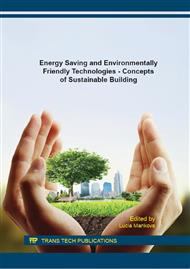p.243
p.251
p.259
p.267
p.278
p.288
p.299
p.307
p.315
Potential of Vegetation in Improving Indoor Thermal Comfort and Natural Ventilation
Abstract:
According to the EPBD (2010) whilst improving the thermal performance of buildings good or at least tolerable thermal comfort conditions must be provided. But better thermal insulation and more airtight buildings increase the risk of summer overheating which makes mechanical cooling inevitable. This idea has been verified by the tendency of the last decade, when people were willing to install and use more frequently air conditioning devices during the summer heatwaves – increasing their energy consumption and electricity bills at the same time. We cannot neglect the importance of studies triggering an efficient way to minimise the cooling load of residential buildings by obstructing solar radiation. The usage of plants in front of transparent surfaces of the façade can avoid indoor overheating. Deciduous plants obstruct buildings’ solar access so that the microclimate around the building is improved too. The use of Green Infrastructure in different levels of planning processes, which would provide sustainable solutions for urban management, is also prescribed in the EU Biodiversity Strategy 2020. Of course in order to investigate the actual effect of trees on indoor thermal comfort we should take into consideration a list of other factors: such as orientation the type and thermal properties of the windows / transparent structures used, and the thermal transmittance values and heat storage capacity of the building. If we have taken into consideration the mentioned factors during simulation we can prove the effectiveness of vegetation for each case. Simulations are made on the base of transparency measurements carried out during the summer of 2014. The shading efficiency of trees is a species-specific attribute because of the varying crown structure and leaf density. Our analyses aimed at the quantification of the transmissivity of characteristic individuals of three frequently planted species (Celtis occidentalis, Sophora japonica, Tilia cordata). The measured data were the amount of transmitted shortwave radiation, compared with a measurement point under unobstructed sunlight. In preliminary studies we have shown that depending on species – a tree in front of the façade can decrease the solar gain on internal horizontal surface up to ~18-30 per cents. As the tree obstructs the solar access of the wall and that of transparent surfaces, a difference in indoor comfort is to be observed too.
Info:
Periodical:
Pages:
278-287
Citation:
Online since:
January 2016
Authors:
Price:
Сopyright:
© 2016 Trans Tech Publications Ltd. All Rights Reserved
Share:
Citation:



